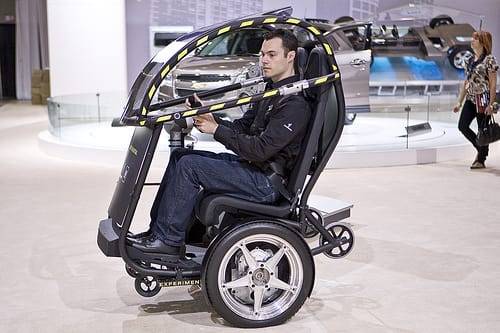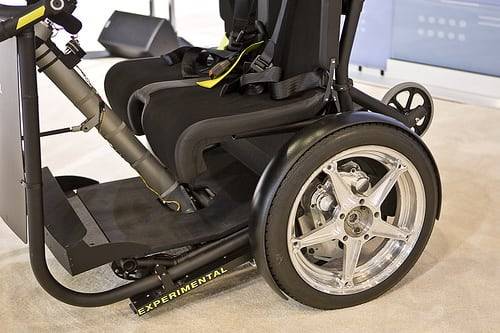Riding Around in the GM/Segway PUMA


Yesterday, I joined the ranks of Meredith Viera, among others, by getting a ride in the PUMA, a two-seat contraption built for trolling around Manhattan-sized concrete jungles. PUMA — which stands for Personal Urban Mobility and Accessibility — is a joint venture between General Motors and Segway, the company that builds the upright two-wheelers you’ve probably seen your local geek using. (Proof of that: I’ve ridden one before.) The PUMA seats two and operates much like a Segway, combining internal sensors with electric motors to balance itself on two wheels. Product designer Derek Hugger took me for a quick spin inside the Javits Center. It’s a bit like a slow-motion roller coaster.

Upon pushing a starter button, the PUMA’s smallish metal floor (your feet are tucked into a lip at its head) rises a few inches off the ground. The entire machine tilts back 10 or 15 degrees — and so do you, as you’re harnessed into your seat. It’s an odd, dangling sensation at first: Imagine tilting back on a wheelchair and being able to balance on its two larger wheels and you’ll get the idea. (I haven’t personally done that, but it’s the same concept. Work with me here.) The wheels constantly rotate a few degrees to keep upright, like a stationary unicyclist. That means the PUMA can’t stay in exactly the same spot unless it’s parked.
The vehicle turns on a dime, accomplished with a steering wheel connected by a lengthy column to the floor. Like a pilot’s joystick, the column tilts forward and back to effect acceleration, braking and reverse. Why don’t you fall backward or tip forward accelerating or braking? Because the PUMA, like a Segway, tilts accordingly and uses your weight as a counterbalance. Again, remember the unicycle analogy. When you’re done, press the stop button and the PUMA tilts upright, lowers its floorboard to the ground and settles on a pair of auxiliary wheels ahead of the main ones.

Program director Chris Borroni-Bird told me the next-generation PUMA — if it’s built and hits the streets — will have an enclosed cabin with full doors. Still, those and the multi-point harnesses do little to assuage my safety concerns. Neither does PUMA’s ability to communicate with other PUMAs, something that could mitigate congestion and accidents. At the end of the day, the contraption’s dimensions make a Smart ForTwo seem like, oh, an S80 — the McDonnell Douglas jet, not the Volvo.
Of course, the PUMA is more of an alternative for a Vespa than a Versa. It’s green, to be sure — the batteries recharge by plugging into a household outlet — but it still has a long road to viability. Especially considering that GM, if you haven’t heard, has bigger fish to fry.

Former Assistant Managing Editor-News Kelsey Mays likes quality, reliability, safety and practicality. But he also likes a fair price.
Featured stories




